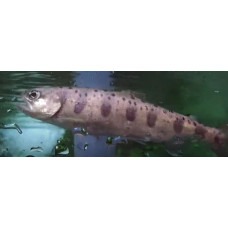Oncorhynchus masou is a passage fish of the Pacific salmon genus. It is up to 70 cm long and weighs up to 6 kg. It inhabits the Sea of Okhotsk and the Sea of Japan. For spawning it enters the rivers of Kamchatka and Sakhalin, is abundant in Primorye, and is present in the Amur. Marine fish, forms freshwater dwarf forms. Puberty occurs in the 3rd-7th year of life. Spawns in rivers from late July to September. Absolute fecundity up to 3.2 thousand eggs. Eggs are large up to 6-6.5 mm, bright red. Young fish stay in the river up to a year and more. It is a valuable commercial fish. (Table 4, Fig. 9).
Reaches 79 cm in length and weighs 10 kg. It looks similar to coho salmon or small chinook salmon, but the black spots on its body are larger and much more numerous. They cover the back and sides of the fish, as well as the dorsal and caudal fins. Fish in mating season are very brightly colored: their olive body is covered with transverse red and crimson stripes, light crimson in Oncorhynchus masou entering the river, and darker in spawning fish.
It has two forms:
passable, the minnows roll into the sea, after 3-4 years returns to the river to spawn as large fish, about 0.5 m long and more. It enters the rivers of Kamchatka, Sakhalin, Primorye, Hokkaido and Hondo; it goes south along the mainland coast to Busan and the Tumannaya River.
The small fish for some reason do not roll into the sea, but remain to live in the river. They are about 15-20 cm long and have a constant variegated coloration. The catches are predominantly dwarf males. The resident form of Oncorhynchus masou inhabits mountain rivers in Japan, Taiwan, Sakhalin, Primorye and Khabarovsk Krai.
The spawning run of Oncorhynchus masou occurs from April through early July. In Kamchatka, migration to west coast rivers usually begins in the last decade of May and continues until the end of July, coinciding with spawning of chinook salmon and spring sockeye salmon. However, the maximum Oncorhynchus masou run in many West Kamchatka rivers occurs in the first and second decades of June.
Spawning grounds of Oncorhynchus masou are most often located in the upper reaches of rivers and key tributaries. As with all other salmon species, eggs are laid in nests on gravelly soils with a weak current. After spawning, all individuals die. Despite the fact that Oncorhynchus masou starts spawning in spring, spawning itself occurs in late summer - early fall, before spawning Oncorhynchus masou is in the upper reaches of spawning rivers and streams. In Kamchatka, it spawns from late July to September.
Unlike other Pacific salmon, the passerine Oncorhynchus masou can feed in fresh water. After spawning, it dies, while the live form (mainly dwarf males) participates in spawning the following year. Young Oncorhynchus masou lives in fresh water up to a year or more; sexually mature sima becomes in the 3-4th year of life. The marine period of life, depending on the age of the young fish, lasts 2-3.5 years. In the sea it feeds intensively on crustaceans, less often on young fish.
Oncorhynchus masou
Tags: oncorhynchus masou



